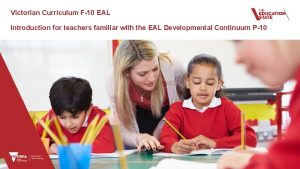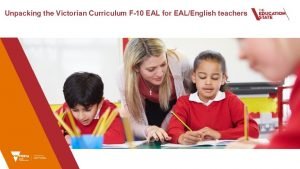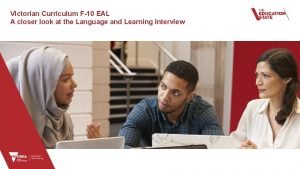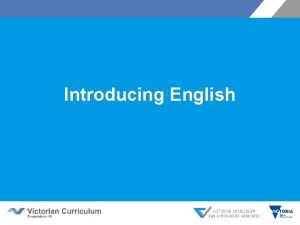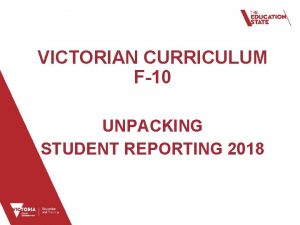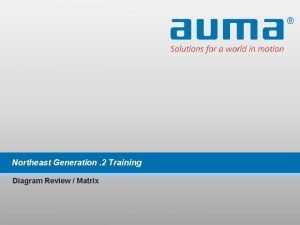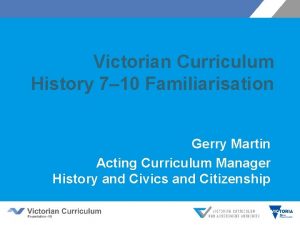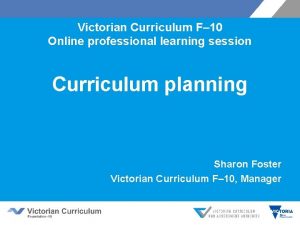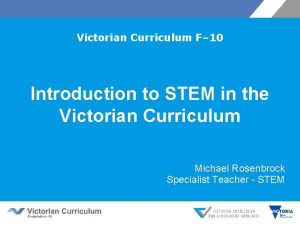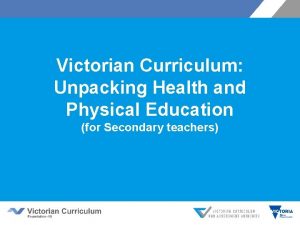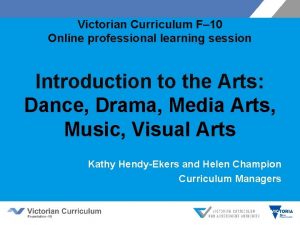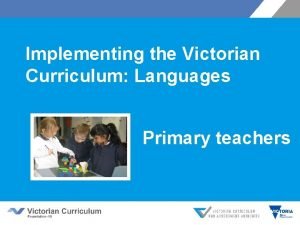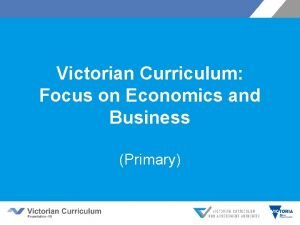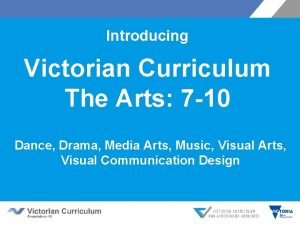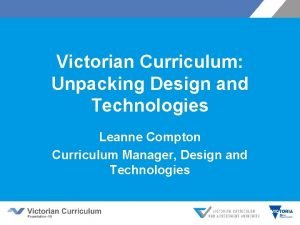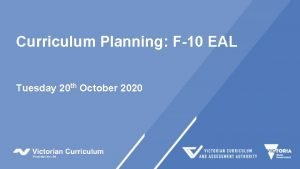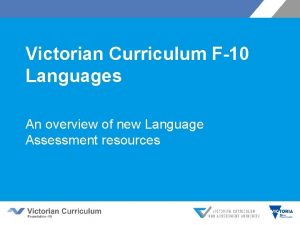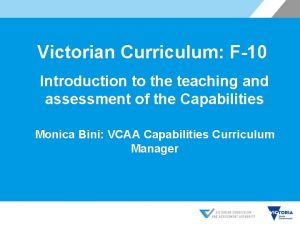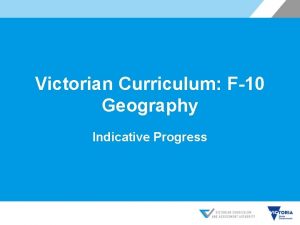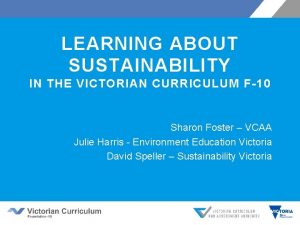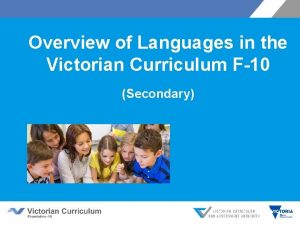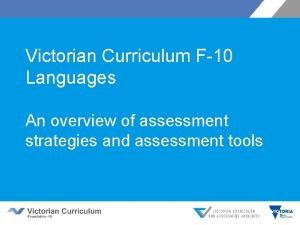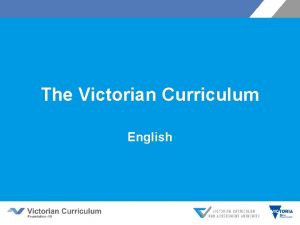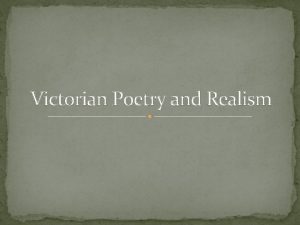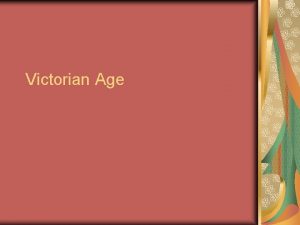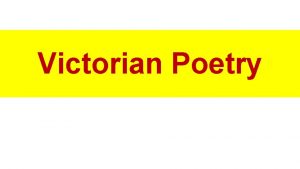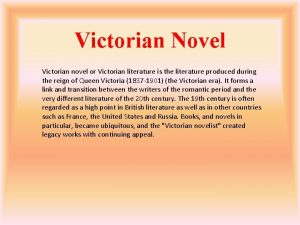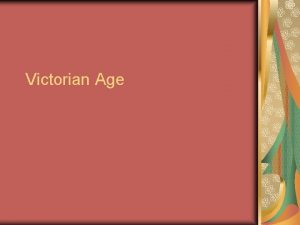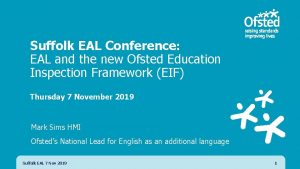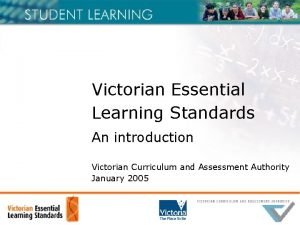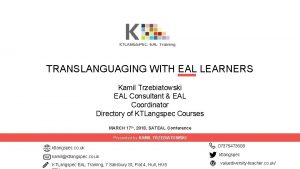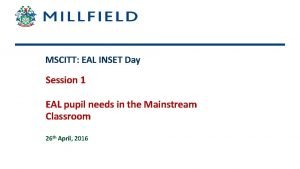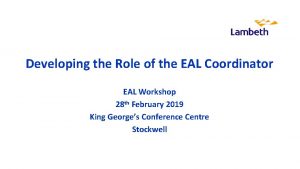Victorian Curriculum F10 EAL Introduction for teachers new

























- Slides: 25

Victorian Curriculum F-10 EAL Introduction for teachers new to EAL curriculum 1

Contents Slide/s 3 Curriculum, assessment and reporting arrangements 2013 -19 4 Curriculum, assessment and reporting arrangements 2020 5 Curriculum, assessment and reporting arrangements 2021 6 Why a new EAL curriculum? Why an EAL curriculum that covers all learning areas? 7 Content of the curriculum 8 Stages vs pathways 9 Understanding the A and B pathways – examples in a primary setting 10 Understanding the C pathway – examples in a secondary setting 11 What do the levels in Pathway A mean? 12 What do the levels in Pathway B mean? 13 What do the levels in Pathway C mean? 14 What else is available? 15 -16 Illustrations of content on the VCAA website 17 Illustrations of content on the VCAA website – elaborations 18 Illustrations of content on the VCAA website – achievement standards 19 Illustration of content in the Scope and Sequence documents 20 What does the new EAL curriculum mean for schools? 21 What does the new EAL curriculum mean for non-specialist teachers? 22 Plurilingual strategies 23 Assessment and reporting 24 Links, resources and contacts 2

EAL CURRICULUM, ASSESSMENT AND REPORTING 2013 - 2019 Curriculum and assessment Reporting EAL Companion to Aus. VELS EAL Developmental Continuum P-10 3

EAL CURRICULUM, ASSESSMENT AND REPORTING 2020 – transition year Curriculum and assessment Reporting EAL Companion to Aus. VELS EAL Developmental Continuum P-10 OR Victorian Curriculum F-10 EAL 2020 Reporting Tool 4

EAL CURRICULUM, ASSESSMENT AND REPORTING 2021 Curriculum and assessment Reporting Victorian Curriculum F-10 EAL Reporting Tool Visit the VCAA Victorian Curriculum F-10 EAL website: Victorian Curriculum F-10 5

Why a new EAL curriculum? Why an EAL curriculum that covers all learning areas? The Victorian Curriculum F-10 EAL: • is the final curricula published in the Victorian Curriculum F-10 • is designed and presented in the same way as all other Victorian Curriculum learning area curricula to provide teachers with consistency and clarity • is designed to take into account the diverse backgrounds and varied prior learning experiences of EAL students in Victorian government schools • recognises that students are being immersed in English medium education, and that this can happen early, mid or late in their school education and development • recognises that students need to access and demonstrate learning in all learning areas, and that therefore all teachers need to: • • understand the language students need to access the content of the learning areas • assess or understand the proficiency levels of the EAL students in their class/es • be able to plan for and support the language learning of EAL students in order to support their learning of content recognises that EAL students might know more than one language and that they are plurilingual, meaning they have a range of linguistic and cultural knowledge that can be activated to support communication and learning in and of English in all classrooms. Read the VCAA Rationale and Aims: Rationale and aims 6

Content of the curriculum Pathways Levels Modes Pathway A – early immersion (Foundation to Year 2) A 1 A 2 Speaking and listening Pathway B – mid immersion (Years 2 to 8) BL B 1 B 3 CL Reading and viewing Strands Communication Sub-strands Communication Text structure and organisation Grammatical patterns Content description Elaborations Achievement standards B 2 Pathway C – late immersion (Years 7 to 10) Speaking and listening achievement standard for each level C 2 C 3 C 4 Writing Cultural and plurilingual awareness Linguistic structures and features Phonology Grapho-phonics C 1 Word knowledge Cultural understandings Plurilingual strategies Content description Elaborations Reading and viewing achievement standard for each level Writing achievement standard for each level 7

Pathways Victorian Curriculum F-10 EAL Levels A 1 A 2 Pathway A – early immersion (Foundation to Year 2) BL B 1 B 2 Pathway B – mid immersion (Years 2 to 8) B 3 CL C 1 C 2 C 4 C 3 Pathway C – late immersion (Years 7 to 10) What is the intent of the overlap in year levels across the pathways? • • ‘Early’, ‘mid’ and ‘late’ immersion refer to the point in a student’s life at which they enter an English-medium education setting. EAL students starting school in Australia will typically be at the immersion level described by the pathways and year levels above The overlap provides flexibility in determining the most appropriate developmental pathway for each EAL student. While typically, a Foundation/Year 1 student will start on Pathway A, a Year 3, 4, 5 or 6 student will start on Pathway B and a Year 7, 8, 9 or 10 student on Pathway C, EAL students starting school in Year 2 might benefit from starting on the pathway that ensures they receive the most developmentally appropriate input, that is Pathway B. • Likewise, a Year 2 student who reaches the end of Pathway A in the middle of the year could move to the upper levels of Pathway B in preference to being transitioned to English. This is because of the increase in cognitive demand academic language between Year 2 and Year 3. An EAL student can appear to be at mainstream level in Year 1 or 2, but then may fall behind in Year 3 as learning and language expectations increase. • Some students may benefit from starting on one pathway and moving to the next when it is developmentally appropriate to do so. For example, a Year 6 student in a P-12 College who is a beginner might remain on Pathway B in Year 7 and even Year 8, if there is continuity of class or teacher, before switching to Pathway C. • In a typical situation, an EAL student enrolling in a secondary school in Year 7 will start on Pathway C and continue on the secondary EAL pathway until he or she transitions to the English standards or undertakes VCE EAL. 8

Understanding the A and B pathways – examples in a primary setting Pathways are not linear. Students may move from one pathway to another before they no longer need the EAL curriculum. Students will progress at different rates through the pathways depending on many factors including language background, prior education, life experiences, family situation, health and well-being. The substages allow teachers to report on student progress when they have not yet reached an achievement standard. Example 1: student progress in all modes A 1. 2 A 1. 3 A 1. 2 A 2. 3 B 2. 2 Student year level Example 2: student progress in all modes Reporting points F A 1. 1 1 A 1. 2 2 A 1. 3 B 2. 2 B 2. 3 3 A 2. 1 B 3. 1 Transition to English curriculum B 3. 3 4 5 A 2. 1 B 2. 2 B 2. 3 B 3. 1 B 3. 2 B 3. 3 Standard achieved Read the VCAA Sample progressions through the EAL pathways: Sample progressions 9

Understanding the C pathway – examples in a secondary setting Pathways are not linear. Students may move from one pathway to another before they no longer need the EAL curriculum. Students will progress at different rates through the pathways depending on many factors including language background, prior education, life experiences, family situation, health and well-being. The substages allow teachers to report on student progress when they have not yet reached an achievement standard. Example 1: student progress in all modes Student year level Example 2: student progress in all modes C 1. 3 C 2. 1 7 C 3. 1 C 2. 2 C 2. 3 8 C 3. 1 C 3. 2 9 C 3. 3 C 3. 2 C 3. 3 10 C 4. 1 C 4. 2 C 4. 3 VCE EAL ENGLISH 11 12 VCE ENGLISH B 2. 3 B 3. 2 Reporting points Standard achieved Read the VCAA Sample progressions through the EAL pathways: B 3. 1 B 3. 3 Sample progressions 10

What do the levels in Pathway A mean? EAL Pathway A: Early immersion (Foundation to Year 2) EAL learners at Pathway A: • are in the early years of their lives and are still exploring the world through concrete experiences • typically develop their language and literacy skills through experiences in the school context • may have some experience of informal prior learning or preschool in Australia or overseas • may have some experience of formal learning in their home language or other languages • are able to interact and communicate using known languages and non-verbal language. Levels A 1 Little or no experience of literacy in English A 2 Emerging/consolidating levels of English proficiency Generally students who enter Foundation are pre-literate, regardless of their language background, and hence there is no Level AL. EAL students who enter Foundation with minimal literacy in other languages will begin their early immersion in English at Level A 1. 11

What do the levels in Pathway B mean? EAL Pathway B: Mid immersion (Years 2 to 8) EAL learners at Pathway B: • have approximately seven to 13 years of life experiences, and have developed some understanding of the world • may have some experience of informal learning in their home language or other languages • may not have experienced formal schooling in any language • may have experienced formal learning (in home language or other languages) that is equivalent to their English-speaking peers • have experience of the social use of at least one language, which they can use as they learn English at school. Levels BL No or limited prior formal learning and no or limited levels of literacy in English and first language B 1 Prior experience of formal learning, beginner levels of English proficiency B 2 Prior experience of formal learning, emerging levels of English proficiency B 3 Prior experience of formal learning, consolidating levels of English proficiency EAL learners without prior formal learning and with minimal home language literacy experience will begin this pathway at Level BL. Depending on their proficiency in English, learners with prior experience of formal learning may begin Pathway B at any other level. 12

What do the levels in Pathway C mean? EAL Pathway C: Late immersion (Years 7 to 10) EAL learners at Pathway C: • have more than 12 years of life experiences, and have developed a good understanding of the world • may have some experience of informal learning in their home language or other languages • may not have experienced formal schooling in any language • may have experienced formal learning (in home or other languages) that is equivalent to their English-speaking peers • have an understanding of themselves and their relations with others in different social contexts • are capable of understanding abstract ideas and relationships in their experience and learning about the world • have experience of the social use of at least one language, which they can use as they learn English at school. Levels CL No or limited prior formal learning and no or limited levels of literacy in English and first language C 1 Prior experience of formal learning, beginning levels of English proficiency C 2 Prior experience of formal learning, beginning/emerging levels of English proficiency C 3 Prior experience of formal learning, emerging/consolidating levels of English proficiency C 4 Prior experience of formal learning, consolidating levels of English proficiency EAL learners without prior formal learning and with minimal home language literacy experience will begin this pathway at Level CL. 13 Depending on their proficiency in English, learners with prior experience of formal learning may begin Pathway C at any other level.

What else is available? VCAA curriculum resources DET support resources Sample progressions Student pathways Language and literacy interview A closer look at the language and literacy interview Rationale and Aims Learning in English as an Additional Language Scope and Sequence Glossary Pathways Level descriptions Reporting tool - substages 14

Illustrations of content on the VCAA website Pathway A selected Pathways Level descriptions Speaking and listening is the first mode listed in the Victorian Curriculum F-10 EAL, followed by Reading and Viewing, then Writing. Levels The Victorian Curriculum F-10 English lists Reading and Viewing as the first mode, then Writing, then Speaking and Listening. Mode Strand Sub-strand Content description Access from the VCAA Victorian Curriculum F-10 EAL website: Victorian Curriculum F-10 15

Illustrations of content on the VCAA website Strand Sub-strand Content description what to teach Content description Sub-strand Content description Each content description has a unique code: • VC – Victorian Curriculum • EAL – EAL • a letter for the strand • C - Communication • L - Linguistic Structures and Features • A - Cultural and Plurilingual Awareness • numerical identifier. Sub-strand Content description Hover and click on a code to see the elaborations for that content description Content description 16

Illustrations of content on the VCAA website – elaborations Sub-strand Content description Hover and click on a code to see the elaborations for that content description Elaborations 17

Illustrations of content on the VCAA website – achievement standards Level Mode Achievement standard 18

Illustrations of content in Scope and Sequence documents provide an overview of content descriptions and achievement standards for each pathway, and show the continua of learning through the content descriptions for each sub-strand. Pathway Levels Mode Strand Sub-strand Content descriptions Access from the VCAA Victorian Curriculum F-10 EAL website: Victorian Curriculum F-10 19

What does the new EAL curriculum mean for schools? Planning for and implementing the new EAL curriculum is a whole-school activity. Specialist EAL teachers need to work collaboratively with generalist primary school teachers and/or secondary subject teachers, to plan and deliver teaching and learning that improves outcomes for EAL students across all the learning areas and capabilities of the Victorian Curriculum. Schools will need to review: • their current EAL teaching programs, or their current approach to providing for EAL learners within their curriculum plans • how the EAL curriculum supports EAL students’ learning in all areas of the Victorian curriculum • how all teachers plan for and teach EAL students in their classes • what professional learning teachers may need in order to implement the EAL curriculum. Existing PLCs or team structures can provide opportunities for teachers who are new to considering the language learning needs of EAL students to discuss and address their needs with the support of peers who are more familiar with EAL teaching. The EAL Curriculum Implementation: School Guide suggests a series of steps for school leaders and teachers to prepare for the implementation in 2021. Read the Department’s EAL Curriculum Implementation: School Guide: School guide 20

What does the new EAL curriculum mean for non-specialist teachers? Teachers of other learning areas do not need to report on the English language proficiency of their EAL students, but they do need to: • understand the language students need to access the content of the learning areas • understand the proficiency levels of the EAL students in their class/es • be able to plan for and support the language learning of EAL students in order to support their learning of content. English teachers may need to assess and report on the progress of some students in their classes against the EAL standards. The Foundation to Year 6 Literacy Teaching Toolkit provides EAL-specific advice to support teachers to differentiate for EAL learners. The Level 7 to 10 Literacy Teaching Toolkit supports teachers to incorporate the literacy of their subject areas into their day-to-day teaching. The interactive e-book EAL Effective Practice Project highlights one Victorian secondary school's implementation of an explicit pedagogy for the teaching of disciplinary literacy in Science and Mathematics. The FUSE resource Unpacking the Victorian Curriculum F-10 EAL content descriptions and elaborations for learning area teachers can be used for self-study or a professional learning session for teachers to support teachers to develop understanding of the curriculum and ideas and strategies to use in the classroom. Access the Literacy Teaching Toolkits: Access the EAL Effective Practice e-book: Literacy Teaching Toolkit EAL Effective Practice Project 21

Plurilingual strategies • • • The Plurilingual strategies sub-strand has been included in the curriculum because EAL students are plurilingual, meaning that they have a range of linguistic and cultural knowledge that can be activated to support communication and learning in and of English in all classrooms. It may represent a change in mindset for some teachers, from expecting that English and English alone is the language of the classroom to understanding that all languages spoken or used by a person form a repertoire that can be drawn upon for learning both content and language. While there are content descriptions relating to plurilingual strategies, these are not included in achievement standards. Teachers are not asked to assess students’ achievement in other languages, but to provide opportunities for students to use their first language and leverage their existing knowledge to support further learning. Elaborations show what this looks like in a classroom. Resources • Find advice embedded within: Foundation to Year 6 Literacy Teaching Toolkit • Read: EAL/D learners are plurilingual • Watch: AITSL – Multilingual approaches to teaching and learning • Watch and listen, or read: Vic. TESOL – The diverse interactions of Aboriginal EAL/D speakers • Watch and listen: Multilingualism and Translanguaging Presentation Plurilingualism (as defined in EAL glossary) The ability of a person who has competence in more than one language to switch between them when necessary for ease of communication and learning. It is the interconnected knowledge of multiple languages. Pathway B, Writing – plurilingual strategies – some elaborations BL miming actions or showing a picture to explain the meaning of the word sought in English B 1 recording the word in home language and English in personal dictionary or vocabulary chart B 2 planning a text collaboratively by discussing ideas, structure and language with same language peers before writing B 3 seeking and giving feedback with peers on draft texts using home language and English 22

Assessment and reporting In 2020 schools that choose to trial part or all of the Victorian Curriculum F-10 EAL can use: • the TEAL assessment resources to plan and support classroom assessment programs • the 2020 EAL Reporting Tool to identify student progress towards the achievement standards (described as ‘Beginning’ or ‘Consolidating’). The 2020 Reporting Tool provides examples of student skills and knowledge at two substages before they meet the Achievement Standard. Substages and levels are also represented numerically as Xx. 1 (Beginning), Xx. 2 (Consolidating), and Xx. 3 (Achieved). The beginning and consolidating substages support teachers to plan for the next stage in a student’s learning, and to report progress where students may not have achieved a standard but have nonetheless progressed in their learning. Sample report format providing level, descriptor, score and student progress for each mode Access TEAL assessment resources: Access the 2020 Reporting Tool: Assessment tools Reporting tool 23

Links, resources and contacts VCAA – Victorian Curriculum F-10 EAL website: includes links to interactive curriculum, Rationale and aims, Structure, Learning in English as an Additional Languages, Scope and Sequence charts and Glossary. VCAA – EAL curriculum area resources: includes Language and literacy interview and sample progressions DET – Tools to Enhance Assessment Literacy for Teachers of EAL Learners – assessment tools and professional learning DET – 2020 Reporting tool: includes substage descriptions and links to work samples DET – EAL Curriculum Implementation School Guide: suggested steps aligned with the FISO Improvement Cycle DET – EAL Developmental Continuum P-10: current to end of 2020 VCAA – EAL Companion to Aus. VELS: current to end of 2020 Other self study or professional learning resources provided in the FUSE resource package: • Unpacking the EAL content descriptions for learning area teachers • Unpacking the EAL curriculum for EAL/English teachers • A closer look at the Language and Literacy interview • Student pathways VCAA – Kellie Heintz, EAL Curriculum Manager heintz. kellie. a@edumail. vic. gov. au (03) 9603 7953 DET – eal@edumail. vic. gov. au (03) 7022 1111 24

© State of Victoria (Department of Education and Training) 2020 Victorian Curriculum F-10 EAL – introduction for teachers new to EAL curriculum is provided under a Creative Commons Attribution 4. 0 International licence. You are free to re-use the work under that licence, on the condition that you credit the State of Victoria (Department of Education and Training), indicate if changes were made and comply with the other licence terms, see: Creative Commons Attribution 4. 0 International The licence does not apply to: • any images, photographs, trademarks or branding, including the Victorian Government logo and the DET logo; and • content supplied by third parties. Copyright queries may be directed to copyright@edumail. vic. gov. au 25
 Eal curriculum reporting tool
Eal curriculum reporting tool Victorian eal curriculum
Victorian eal curriculum Victorian curriculum eal
Victorian curriculum eal Victorian curriculum english
Victorian curriculum english Vcmna
Vcmna Auma india epac wiring diagram
Auma india epac wiring diagram F10
F10 Which era is known for symmetrical tree like designs
Which era is known for symmetrical tree like designs Renaissance floral design history
Renaissance floral design history Kim kroll teachers pay teachers
Kim kroll teachers pay teachers Health and physical education victorian curriculum
Health and physical education victorian curriculum Victorian curriculum history
Victorian curriculum history Vic curriculum progression points
Vic curriculum progression points Victorian f-10 curriculum
Victorian f-10 curriculum Music victorian curriculum
Music victorian curriculum Victorian curriculum economics
Victorian curriculum economics Different types of dinosaurs
Different types of dinosaurs Victorian curriculum health and physical education
Victorian curriculum health and physical education Victorian curriculum visual arts scope and sequence
Victorian curriculum visual arts scope and sequence Language
Language Victorian curriculum economics
Victorian curriculum economics Dance curriculum victoria
Dance curriculum victoria Critical and creative thinking vic curriculum
Critical and creative thinking vic curriculum Victorian curriculum technology
Victorian curriculum technology Victorian curriculum intercultural capability
Victorian curriculum intercultural capability Victorian curriculum history
Victorian curriculum history
